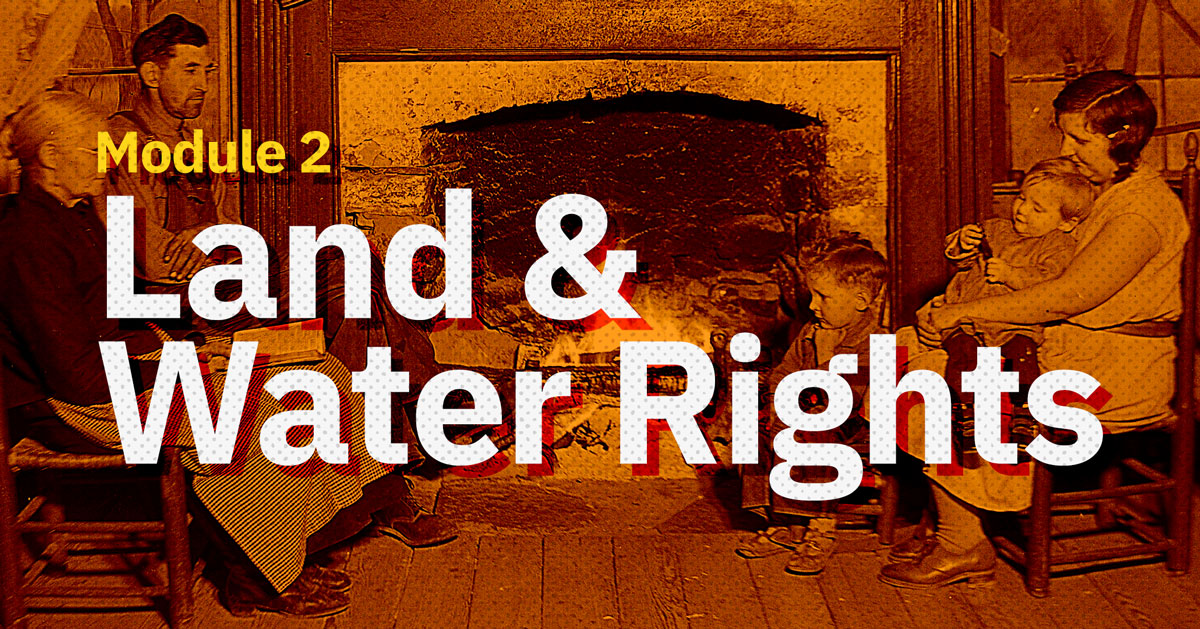
Module 2: Land & Water Rights
In this lesson, students will explore the U.S. government’s use of annexation and eminent domain in both rural and Indigenous communities. Students will examine if rights have been protected or denied to these groups. The history of Indigenous peoples in this country has been marked by profound tragedy since explorers and colonizers first arrived in North America, while rural communities in the United States have long been marginalized and underserved.
Lesson Plan: Day 3
- Welcome students to social studies.
- Use partner teach-backs where each student gets a vocabulary word and explains it to a classmate using the vocabulary slide deck for Day 3 (slide 13) as support.
- Using slide 5 of the Land & Water Rights: Comparing Communities slide deck, ask students why rivers and waterways are important to communities. Possible answers may include a source of fresh water, transportation, irrigation, hydroelectric power, food, etc.
- Ask students whether someone can own a river, and conduct a quick voting exercise for students to take a stance on this question.
- Using slide 6 of the Land & Water Rights: Comparing Communities slide deck, discuss the definition of water rights: the legal permissions that allow the use of water from a specific source for a beneficial purpose.
- Explain that the class will be simulating a water-rights scenario. There will be four rounds in this activity. Use slide 7 of the Land & Water Rights: Comparing Communities slide deck to explain the procedure.
- Round 1: Distributing River Ownership
- Distribute the River Certificates of Ownership to three students at random. Students are simulating the role of “owner” of one of the three rivers: the Colorado River, Columbia River, or Tennessee River.
- Tell the class that these three students are owners of their respective river.
- Ask the owners for what purposes they will use their water. Owners can seek counsel from classmates. Possible answers may include drinking water, hydroelectric power, recreation, irrigation, etc.
- Ask the owners how they feel about being the sole owners of this natural resource.
- Round 2: Increased Population
- Tell the owners that the population around their rivers has increased, and their rivers need to be shared with other owners.
- Introduce three new students who will also be given partial ownership of each river.
- Each original owner must now distribute sections 2, 3, and 4 of their River Certificates of Ownership.
- Ask the newest owners how they feel about their ownership of this natural resource.
- Ask the original owners how they feel about sharing the ownership.
- Round 3: Further Population Growth
- Tell the owners that the population around their rivers has increased again and the rivers need to be shared with other owners.
- Introduce three new students who will also be given partial ownership of each river.
- Each original owner must now distribute sections 5, 6, and 7 of their River Certificates of Ownership. The original owner will retain section 1 of their certificate.
- Ask the class how owners might manage with even less water.
- Ask the class what conflicts might arise from this situation.
- Round 4: The Final Challenge
- Announce that anyone left without strips has no access to water.
- Ask students if they think this scenario could reflect real-world issues regarding water rights. Possible examples might include areas in the west and southwestern United States dealing with drought, increased population, and the mismanagement of resources, which is impacting availability of fresh water.
- To summarize this simulation, facilitate a brief discussion by asking the following questions:
- What are water rights?
- What does this activity teach us about resource management?
- Do you think water really can be owned?
- Do you think laws and regulations are needed to protect water rights?
- Thank students for their participation in this democratic simulation and civic conversation.
Universal Design for Learning (UDL)
- Introducing a new concept through simulation provides access entry points for all learners.
- River owners could be established in teams of three to engage more students, as needed.
Multilingual Learners (ML)
Social-Emotional Learning (SEL)
Civic Skills & Dispositions
Extending Learning
- Tell students we will now explore more about water rights in both Indigenous and rural communities.
- Distribute copies of Text 1: Excerpts from the Water Rights Act.
- Read each section aloud, or have students read aloud in trio groups.
- While listening, have students annotate the section by circling unfamiliar words or phrases.
- Provide the background information for the students. Follow the steps outlined in the Day 3 Land & Water Rights Paideia Seminar Plan section titled “Background Information on Text 1.”
- Distribute copies of Text 2: Excerpts from the Center for Rural Affairs Water Policy.
- Read each section aloud or have students read aloud in trio groups.
- While listening, have students annotate the section by circling unfamiliar words or phrases.
- Provide the following background information for the students. Follow the steps outlined in the Day 3 Land & Water Rights Paideia Seminar Plan section titled “Background Information on Text 2.”
- Have participants share the words and phrases they found unfamiliar while a volunteer lists them on the board.
- Instruct each group to reread the text selections, slowly highlighting the three most impactful lines or sentences. Then, in the selections’ margins, write notes about what makes those lines or sentences compelling. To support the students’ efforts to annotate the text, consider providing the following guidance:
- Think about which three sentences/statements you think are most powerful or important and highlight them.
- Why do you think the statements you highlighted are among the most important in this section? Note your reasoning in the margin near each highlighted statement.
- Consider notating any text selection that makes reference to land and water rights that have been denied or protected.
Universal Design for Learning (UDL)
- Utilize text-reader technology to provide audio options for texts.
- Offer pre-highlighted and annotated versions of the texts for students who may need additional support and scaffolding.
- Utilize the Land & Water Rights: Comparing Communities slide deck for vocabulary support starting on slide 12.
Multilingual Learners (ML)
Social-Emotional Learning (SEL)
Civic Skills & Dispositions
- Inform students that as a class, they will now participate in a conversation about water rights.
- Define and state the purpose of the seminar. Follow the steps outlined in the pre-seminar section of Day 3 Land & Water Rights Paideia Seminar Plan section titled “Define and State the Purpose of the Seminar.”
- Describe the responsibilities of the facilitator and participants. Follow the steps outlined in the Day 3 Land & Water Rights Paideia Seminar Plan section titled “Describe the Responsibilities of the Facilitator and Participants.”
- Have participants set a personal goal. Follow the steps outlined in the Day 3 Land & Water Rights Paideia Seminar Plan titled “Have Participants Set a Personal Goal.”
- Agree on a group goal. Follow the steps outlined in the Day 3 Land & Water Rights Paideia Seminar Plan section titled “Agree on a Group Goal.”
- Using slide 9 of the Land & Water Rights: Comparing Communities slide deck, guide students to complete the Before Seminar section of the Land and Water Rights Paideia Seminar Organizer.
- Conduct the Paideia Seminar by following the steps outlined in the Day 3 Land & Water Rights Paideia Seminar Plan.
- Remind students there is space to record ideas and wonderings as they listen to and participate in the section titled “During the Seminar” on the Land and Water Rights Paideia Seminar Organizer.
Universal Design for Learning (UDL)
- Provide visual guides on the expectations of the seminar.
- Use timers or visual cues during the seminar to help students manage time effectively for each question.
Multilingual Learners (ML)
Social-Emotional Learning (SEL)
Civic Skills & Dispositions
Extending Learning
- Congratulate students for successfully participating in this civic conversation.
- Thank the students for their focused and thoughtful participation in the seminar.
- Have students complete the “After the Seminar” section of the Land and Water Rights Paideia Seminar Organizer.
- Allow time for students to reflect on their participation and that of the class.
- Students will self-evaluate the success of accomplishing their personal goal and the class goal, as well as reflect on the seminar experience.
Universal Design for Learning (UDL)
- Allow students to capture their reflections via audio or video recording.
- Use anchor charts to help students understand what effective group work and individual contributions means.
Multilingual Learners (ML)
Social-Emotional Learning (SEL)
Civic Skills & Dispositions
- As a culminating activity, students should engage in small-group discussions to recall what they have learned throughout this module. Provide a few minutes for them to engage in reflective conversation. Conversation starters may include the following:
- Do you see any similarities between rural and Indigenous communities?
- Did you recognize any connections to life in your own community?
- Students will complete an Exit Ticket to answer the inquiry question for this module: “Who has the right to own land and water?”
- Consider using the Inquiry Reflection Tool for student self-reflection on their experience with this learning module.
Universal Design for Learning (UDL)
- Allow multiple formats for students to respond to the exit ticket.
Multilingual Learners (ML)
Social-Emotional Learning (SEL)
Civic Skills & Dispositions
Extending Learning






